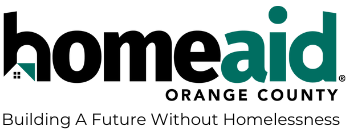
Learning is the First Step
Education
Through collaborative presentations and various public/private partnerships, HomeAid works to educate our community about the crisis of homelessness and to advocate for our neighbors experiencing or at risk of homelessness.
Igniting Interest in the Crisis & the Resolution
At HomeAid Orange County, we believe that every person deserves the dignity of a safe space to call their home. We take an active role in county-wide efforts to build emergency shelters, as well as bridge and affordable housing, because we know we can’t achieve our mission alone.
Our Executive Director, Gina Cunningham, sits on the United to End Homelessness leadership council, in addition to the City of Orange Chamber of Commerce. In order to further our partnership-based model, we also work collaboratively with our founders, the Building Industry Association of Southern California, as well as the County of Orange, and our 30 nonprofit service provider partners.
Regularly, our Education & Advocacy team, led by our Vice President of Advocacy, Peter Whittingham, makes presentations to local city and county leadership about the crisis of homelessness.

The Crisis is Growing
The number of people experiencing homelessness in Orange County increased steadily from 2015 to 2020. Making matters more difficult for people at risk of homelessness is the rising cost of living in the county while wages for minimum wage stagnate.
HomeAid is committed to developing affordable housing options for our neighbors experiencing or at risk of homelessness.
You can join HomeAid in supporting those in need by donating your time and/or resources such as diapers, non-perishable food, and clothing.
People Experiencing Homelessness in Orange County
Learning About Homelessness
-

United to End Homelessness
The United to End Homelessness initiative, empowered by United Way, is a collaboration between Orange County businesses, philanthropic, governmental, and faith-based groups, including HomeAid Orange County.
Monthly, United to End Homelessness hosts virtual workshops for the community to learn about homelessness and what each of us can do to help people in need.
-

National Alliance to End Homelessness
The National Alliance to End Homelessness is a nonpartisan organization committed to preventing and ending homelessness in the United States.
The Alliance’s Center for Learning is a comprehensive online resource of information and learning tools that can help one to better understand homelessness.
The State of Homelessness: 2023 Edition, created by National Alliance to End Homelessness, uses data from the U.S. Department of Housing and Urban Development (HUD) to provide an overview of the scope of homelessness in the U.S. on a given night in 2022, and illustrate emerging trends. Data in this report is pulled from HUD’s 2022 Point-in-Time (PIT) Count data, as well as Housing Inventory Count data. Learn more.
-

Commission to End Homelessness
The Commission to End Homelessness is a collaborative effort with many groups and organizations, including HomeAid Orange County.
The Commission works in collaboration with the County government, 34 city governments, the business sector, philanthropic organizations, community organizations, health care, and public safety, to promote an effective response to homelessness within Orange County.

Each Type of Housing is Unique and Important
Over the years, HomeAid Orange County has constructed various types of housing. Each type of housing is meant to serve a specific purpose and population of people for a designated period of time. There are proven models for housing that provide critically needed support for residents while also providing pathways for people to end their experience of homelessness permanently. The below types of housing are standard across the nation and follow the HUD (Housing & Urban Development) classifications.
Emergency
Emergency shelters are meant to serve as the first place people turn to when experiencing homelessness. Emergency shelters provide support services and short-term stabilization with a focus on finding appropriate housing that meets people’s long-term needs.
Example: our HomeAid Family CareCenter
Bridge/Transitional
Bridge Housing is a program that provides a temporary residence, ranging from 6 months to 2 years. It was previously referred to as “transitional” or “interim” housing. Bridge Housing includes supportive services that further help people find permanent housing as quickly as possible.
Example: Casa Teresa I, II, and III
Affordable & Permanent Supportive
Affordable Housing is long-term housing (1-8 years) that includes supportive services for people experiencing homelessness. Often this form of housing requires a voucher to ensure the affordability of the unit at a specific percentage of the Area Median Income (AMI).
Permanent Supportive Housing, commonly referred to as PSH, is affordable housing for our neighbors who are chronically homeless with a diagnosed disability.
Example: FX Residences
Annually, the month of November is Homelessness Awareness Month for all HomeAid Affiliates across America.
During Homelessness Awareness Month, we focus on the crisis of homelessness, the difficulties that people experiencing or at risk of homelessness face, and what YOU can do to help end homelessness.

